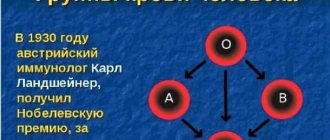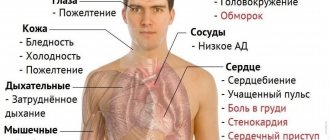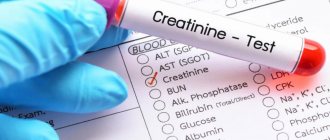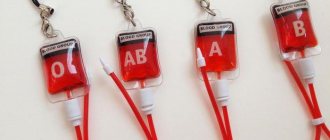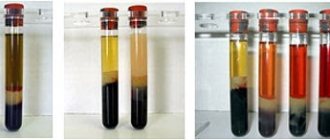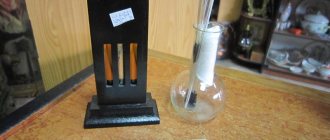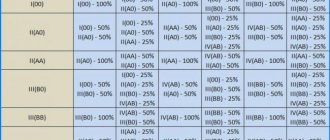It is useful for every person to remember their blood type. This can unexpectedly come in handy in emergency situations. It’s not for nothing that military personnel have their blood type marked on their tunic or badges. There is no problem with how to determine your blood type. In large medical institutions, laboratories do this. But even in small rural outpatient clinics there are standard kits for determining the group, and all doctors and paramedics are able to carry out the analysis. There is no need to do this on your own when there are specialists.
What blood type a child has can be guessed from his parents. For example, knowing that the parents have the second, third or fourth, you should not hope that the child will have the first.
Tips for home determination
Similar advice is given by people who “live” on the Internet and collect any information indiscriminately. Sometimes they reinterpret it in their own way.
Indeed, there is a theory of nutrition depending on blood type and attempts have been made to connect personality with it. But this was developed to select the most suitable diet and prevent diseases. Even psychologists have stopped talking about the connection between personality type and blood number.
Moreover, you cannot judge your group by your favorite dishes or inclination towards leadership.
It is better to learn anything at home from full-fledged articles and consultations with specialists. There may be medical documents (outpatient records, hospital records) that contain information about your blood.
At the request of donors and hospital patients, the passport can be stamped with this information.
Similar stripes are used on army uniforms.
Nutrition
The irrepressible passion of representatives of the third positive group for everything “delicious, sweet, spicy” and the desire to pamper themselves with a loved one can create health problems such as digestive disorders, intestinal dysfunction, the development of diabetes and obesity.
Taking into account the fact that the body of “nomads” is, in principle, omnivorous, intolerance to any product is not typical, it is easy for them to choose a diet that would be healthy, tasty and not harmful. For this purpose, the following products are recommended:
- dishes made from lean meats;
- fish and seafood dishes;
- various porridges, with a preference for rice and oatmeal;
- eggs;
- low-fat dairy products, including cheeses;
- boiled and raw vegetables in the form of salads with vegetable oil;
- drinks made from medicinal herbs (chamomile, St. John's wort, lemon balm, rose hips).
Products that are not recommended for consumption:
- pork meat, lard and fatty chicken;
- smoked meats;
- tomatoes and dishes made from them, tomato juice and ketchup;
- all kinds of sweets - ice cream, pastries, pies, sweets, they should be replaced with fruit, or light fruit cakes without baking.
Acceptable, but with restrictions: black tea and coffee, corn, legume dishes, nuts, spicy and hot seasonings. Meals should be more frequent, without waiting for feelings of extreme hunger, when overeating is often allowed.
Who invented blood groups
The discoverer of the four blood groups is the Austrian scientist and physician K. Landsteiner, who received the Nobel Prize in Medicine for this in 1930. The discovery made it possible to prevent deaths due to transfusion and to study the compatibility of donor characteristics and the recipient in advance.
The essence of the proposed AB0 system is the presence of antigenic structures on erythrocytes in humans and animals. There are no typical antibodies (gammaglobulins) to them in the plasma. Therefore, the “antigen + antibody” reaction can be used for determination.
Prevalence of blood groups by nationality
The adhesion of red blood cells occurs when an antigen meets its antibody. This reaction is called hemagglutination. It is visible during analysis in the form of small flakes. Determination of blood group is based on obtaining an agglutination pattern with standard sera.
Antigens of erythrocytes of type “A” bind to antibodies “ά”, respectively “B” to “β”. Based on blood composition, the following are distinguished:
- I, or 0 (ά, β) - there are no antigens on the surface of red blood cells;
- II, or A (β) - contain antigen A with antibody β;
- III, or B (ά) - there is a type B antigen with antibody ά;
- IV, or AB(00) - has both antigens, but does not contain antibodies.
Antigens are present in the human embryo already in the embryonic period, and antibodies (agglutinins) appear in the serum of newborns during the first month of life.
Blood compatibility for conception
Family planning is a very good direction in obstetrics, which has significantly reduced the number of complicated or unwanted pregnancies. This was manifested by the birth of fewer seriously ill children. Today, every woman knows about all the threats that can await her and her child if she has a cold-blooded attitude towards some of the details of proper family planning. One of these details is the compatibility of the blood of sexual partners.
In fact, this topic is a little misunderstood in the media. Everyone who has misunderstood it interprets everything in their own way, spreading unreliable and, most importantly, untrue information. In this regard, it is worth considering the issues of immunological compatibility of spouses and blood compatibility of spouses at conception, which were mixed with each other and are discussed as one and the same problem. This spreads panic and forces people to search for a non-existent truth. Therefore, it is important to understand that:
- The compatibility of spouses when a woman is unable to get pregnant depends not on the compatibility of blood groups or the Rh factor, but on the immunological compatibility of the woman and the man. This means that antibodies are produced to the components of a particular male sperm in the woman’s body, which simply does not perceive it. The group and the Rh factor have nothing to do with it at all;
- An Rh negative mother can give birth to a baby with Rh positive blood. This can only affect the course of pregnancy and the condition of the fetus, but cannot be regarded as incompatibility with the Rh factor for conceiving a child;
- A couple with different Rh factors can easily have healthy children. There is no need to ruin relationships because the Rhesus of the mother and fetus could potentially be incompatible. But you should definitely follow the family planning recommendations that experts will point out. Some of these recommendations are listed in the next section.
It is impossible to reliably predict the development of Rh-conflict pregnancy.
Standard blood typing (simple method)
To perform a blood group test, the patient's red blood cells (taken from a drop of blood) and standard serum containing known antigens are needed.
Serums are made from donor blood at “Transfusion Stations”, have expiration dates, and require compliance with storage conditions. The series number is indicated on the ampoules. For accurate analysis, two sets of sera of different series are taken. This is done to eliminate errors.
A large drop of four sera is placed in two rows on a flat plate (only III and II are sufficient, but 1 and 1V are also taken for control). Using different glass rods (it is convenient to use eye pipettes), add the blood to be tested into the serum drops (the ratio should be approximately 1:10) and stir gently.
The plate is rocked for five minutes, allowing the serum to mix well with the blood.
Decoding the results
5 minutes pass and the analysis results can be assessed. In large drops of serum, clearing occurs, in some small flakes are formed (agglutination reaction), in others they are not. Here are the possible options:
- if there is no agglutination in both samples with sera of groups III and II (+ control 1 and 1V) - this is the first group;
- if coagulation is noted in all except II, this indicates the second group;
- in the absence of agglutination only with III serum, the third blood group is established;
- if coagulation is observed in all samples, including the 1V-control - group four.
When the sera are arranged in the correct order, with signatures on the plate, it is easy to navigate: where there is no agglutination, there is a group.
There are times when the bonding is not clearly visible. Then the analysis is redone, fine agglutination is examined under a microscope.
Cross reaction method
To clarify the group in case of unexpressed agglutination, the method of double cross-reaction with standard erythrocytes is used. In this case, it is not the serum that is known, as in the simple method, but the erythrocytes. The patient's blood is drawn into a test tube, centrifuged, and the serum is pumped out from above with a pipette for testing.
Standard antisera
2 large drops of serum from the patient are dropped onto a flat white plate. They add standard red blood cells A (II) and B (III) blood groups. Stir gradually and shake the plate.
The result is assessed after 5 minutes:
- if agglutination occurred in both drops, group one;
- if not in any sample, group four;
- if in one of the known red blood cells used, then the group is determined by the presence or absence of coagulation in the drop.
Why is this data needed?
Many people still don’t understand why everyone should have as much information as possible about their health. And the first of the necessary data is the Rh factor and group.
- When preparing for pregnancy, information is required from both partners in order to reduce the risks of Rh conflict in the early stages.
- During transfusion, since today clinics try to carry out the procedure only with identical indicators in order to reduce the risks of rejection.
- Before undergoing surgery or organ or bone marrow transplantation.
Anyone can find themselves in a situation where this information is needed to obtain emergency medical care, when seconds count. Therefore, many are now trying to put their blood type in their passport and be prepared for unforeseen circumstances.
Note! It is not recommended to donate blood more often than 3-5 times a year. In order not to forget the time of the last submission, it is recommended to write down the dates.
In traditional medicine, there are 4 types of blood, designated in official documents as:
- 0 – first group,
- A - second,
- B - third,
- AB – fourth group.
There are two separate Rh factors: positive (+) and negative (-). Ignorance of blood characteristics can lead to serious and life-threatening consequences.
Read also: Causes of poikilocytosis in a general blood test and characteristics of the pathology
Definition of a group by zoliclones
Zoliclones are synthetic serum substitutes. They contain artificial substitutes for agglutinins ά and β. They are called erythrotests “Tsoliklon anti-A” (pink) and “anti-B” (blue). The expected agglutination occurs between the erythrocytes of the blood being tested and the agglutinins of the coliclones.
The technique does not require the use of two series and is considered more accurate and reliable. The procedure and evaluation of results are the same as in the simple standard method.
| Type of zoliclons | Blood type | |
| Agglutination result | Anti-A | Anti-B |
| — | — | 0(I) |
| + | — | A(II) |
| — | + | B(III) |
| + | + | AB(IV) |
Feature: the fourth group AB (IV) is necessarily confirmed by an agglutination reaction with a specific anti-AB zolicone and the absence of nonspecific adhesion of erythrocytes in an isotonic sodium chloride solution.
What documents contain this information?
Many people have no idea where their blood type is written. The first document in which health information is stored is certificates received at birth. All newborns must have a health card. This medical document contains the Apgar score the baby receives at birth, blood notes, weight, height, and the results of specialist examinations. Parents are strongly advised to keep the card, for example, to redirect from one clinic to another when moving.
This information can be included in an insurance certificate, military ID, or even a passport. However, it often happens that a child’s card is lost, and you need to find out the blood characteristics.
